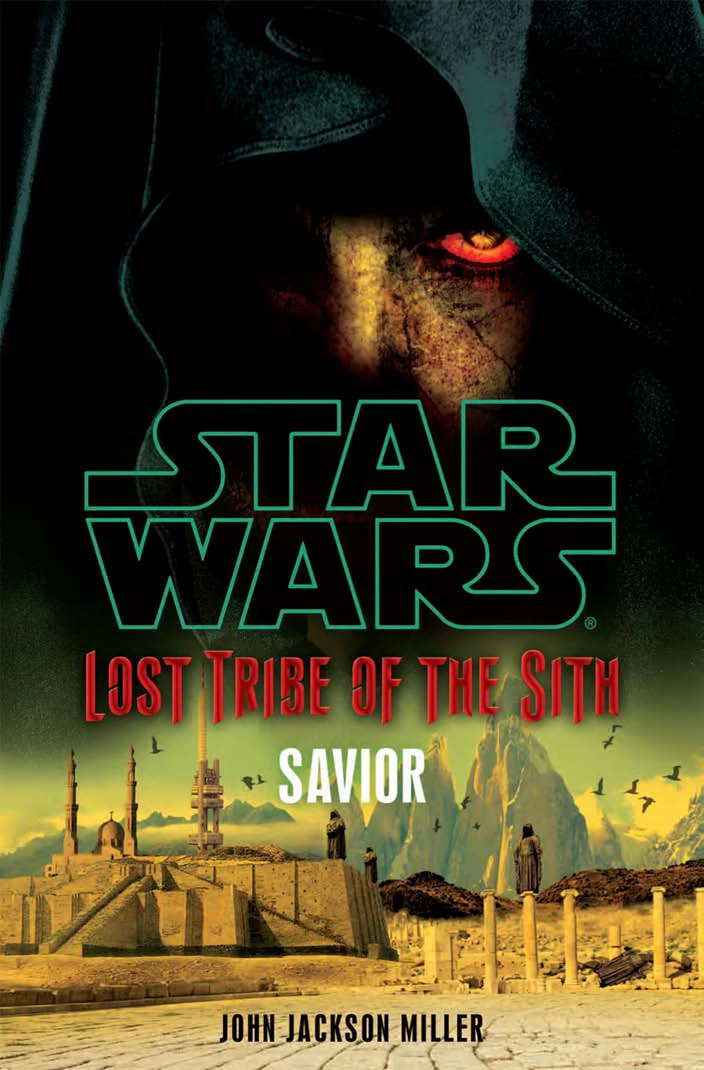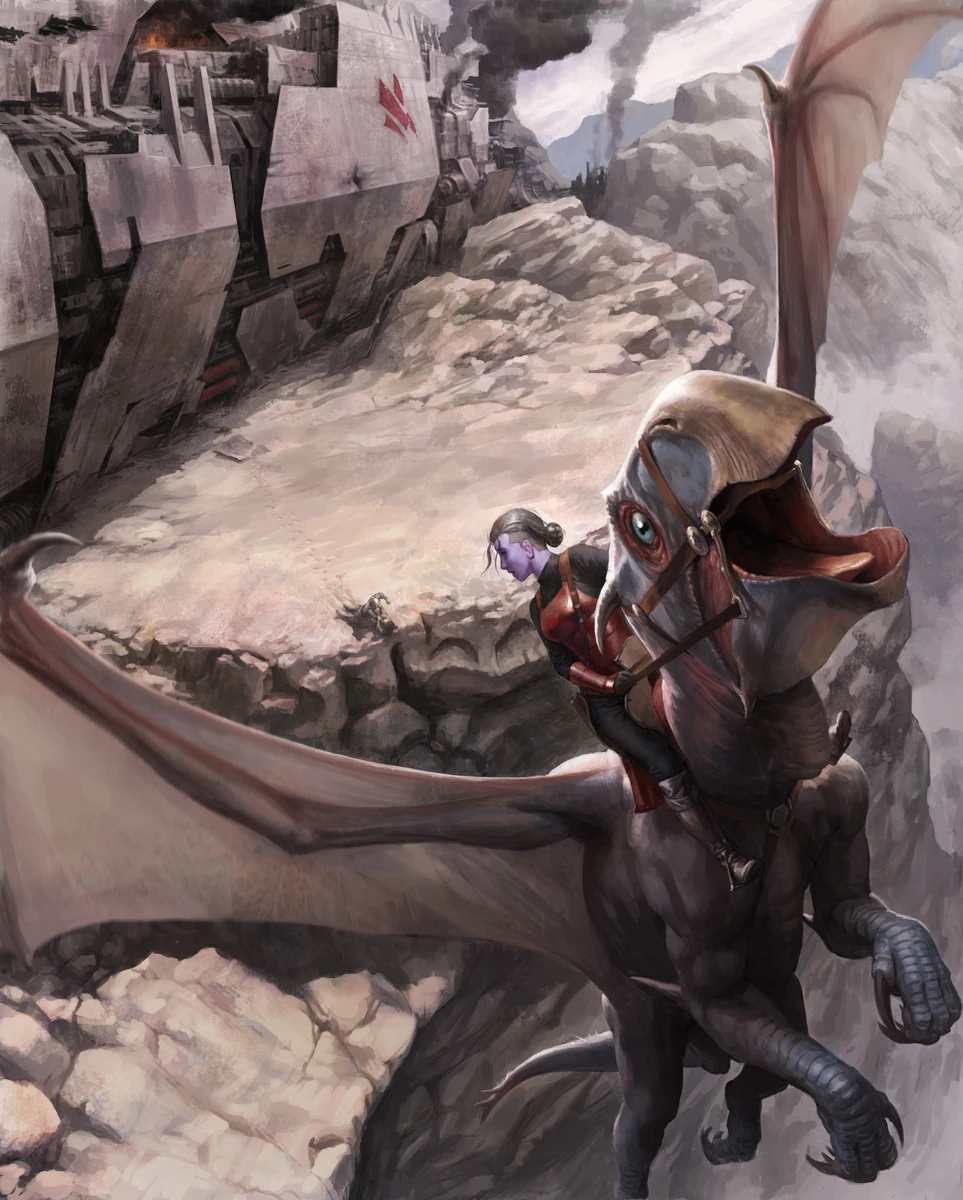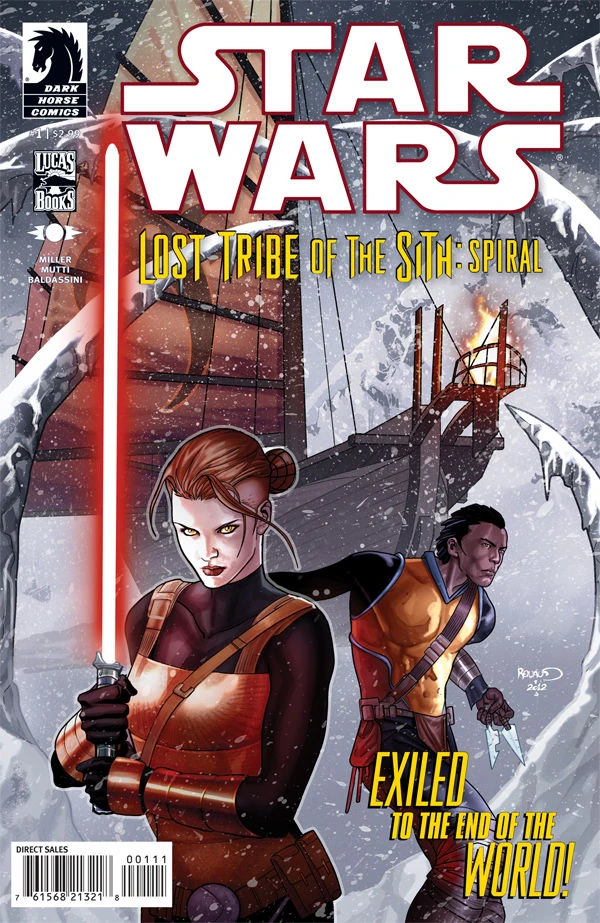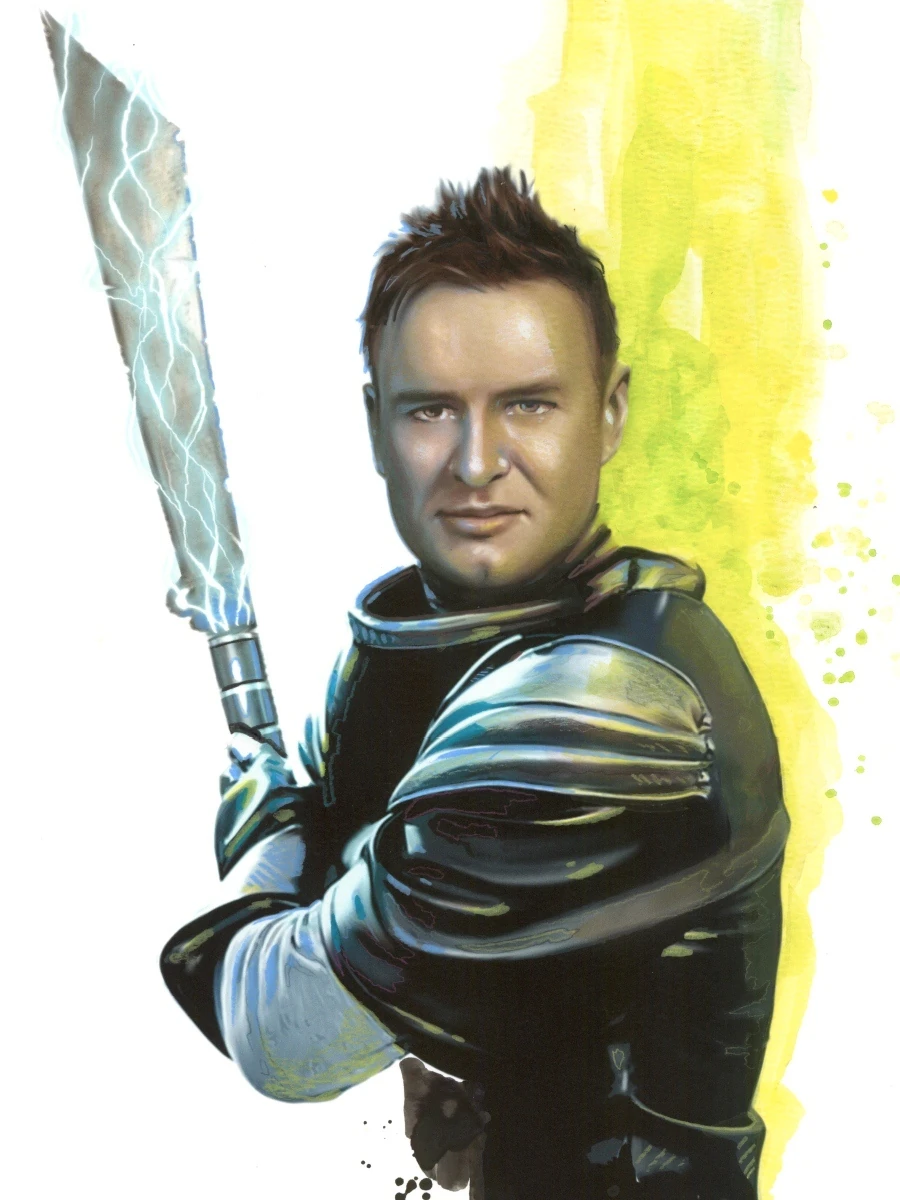The next item on the Star Wars Legends Read-Through list was the Lost Tribe of the Sith series of short stories. These stories detail the history of the so-called "Lost Tribe", a splinter from the original Sith Empire that survived, hidden from galactic history for over five millennia (appearing the Fate of the Jedi novels, which I will read in several years). It also served to address inconsistencies between how the Sith were depicted in the Tales of the Jedi comics vs. how the Tribe appears in the Fate of the Jedi novels.
For this post, I read the following:
The Lost Tribe of the Sith establishes for itself a government and military, with the ship's Captain, Yaru Korsin as the Grand Lord. Korsin's wife (initially his sister-in-law) Seelah plots to purify the Tribe, and plots the death of all non-human crewmembers. After a power struggle between Korsin, Seelah, her son Jariad -- during which Keshiri leader Adari Vaal attacks the Sith by absconding with an enormous amount of their flying mounts, disappearing forever -- Korsin's daughter Nida takes over and leads Kesh into a new age. However, given the lack of metals in the planet's crust, they cannot develop advanced technology and return the stars.
A millennium later, a single Jedi -- an agent of the Jedi Covenant -- discovers Kesh, but cannot escape to report his findings. He lives as a poor farmer for many years, until he is discovered and blows up his nearly-repaired ship to ensure the Sith cannot rebuild their intergalactic Empire.
Over the centuries, the Sith government collapses due to in-fighting, with different factions representing the different viewpoints of their ancestors. The revelation that Captain Korsin was but a pawn of the monstrous Dark Lord Naga Sadow causes civilization to break down further, but when historian Varner Hilts learns of a second continent on Kesh, the people are united under a new cause: conquest. The Sith invent airships to travel to this other continent, where they find the people there had been warned about a potential Sith invasion millennia earlier. One of Grand Lord Hilts's rivals invades the new continent, hoping to claim it for himself, but Hilts was prepared and manages to peacefully convince these new Keshiri of his peaceful intents and integration into a wider Sith society.
Shortly thereafter, Hilts's daughter Takara and an outcast called Spinner discover another ship that crashed on Kesh centuries before Omen, holding dangerous Dark Jedi. Takara and Spinner stop them, but at the cost of the ability to leave Kesh for further millennia.
All of that contributes to my next point: the world-building in these short stories is remarkable. The Fate of the Jedi novels established a few basic facts about the Lost Tribe (Sith society of perfect-looking humans, native Keshiri generally considered inferior, red lightsabers powered by special crystals, glass knives, descended from Naga Sadow's Empire, cannot escape Kesh). John Jackson Miller takes whatever information he is given and builds a detailed history spanning millennia. The first four ebooks, all set in the first quarter-century after the Omen's crash, establish Sith dominance over the Keshiri and a few cultural and governmental ideas (the value of physical perfection, the hierarchy of High Lords and Grand Lords, etc.) Miller then allows the society to change over its 5,000-year history. There are times where it prospers, while in others it suffers extreme declines. For example, there is a period of several centuries called the Time of the Rot, in which in-fighting between different factions nearly destroys the entire Tribe. This period only ended when the new Grand Lord Hilts unifies the people under a new cause (thus naming this new period the Hilts Restoration). By establishing the Sith society and allowing it evolve over time, Miller makes it feel very real.
I also like how Miller tied this into other works, including his own. He wrote the Knights of the Old Republic comic that introduced the Jedi Covenant, who watched for the return of the Sith. The Jedi Knight Jelph was lost after Zayne Carrick took down the Covenant, and ended up on Kesh by mistake. This is a nice touch, and helps connect this story with others. He also expands the scope of the old Sith Empire and the Great Hyperspace War in a meaningful way. I noted in my blog post about the Tales of the Jedi comics that those stories told focussed stories during major galactic conflicts. The Lost Tribe books help make the Great Hyperspace War feel like the massive event it must have been.
The only problem I see is with Spiral. The comic arc seems tacked on after a perfectly adequate ending in Pandemonium. Unless the plan was for Spiral to be the first of several comic arcs, I would have preferred the story ending with the novella.
Overall, these short stories were a fun diversion into a well-developed, isolated society that would only become of concern to main story protagonists MUCH later in my reading timeline.
Follow @C_Andrew_H
For this post, I read the following:
- Lost Tribe of the Sith: Precipice (short story by John Jackson Miller, 2009)
- Lost Tribe of the Sith: Skyborn (short story by John Jackson Miller, 2009)
- Lost Tribe of the Sith: Paragon (short story by John Jackson Miller, 2010)
- Lost Tribe of the Sith: Savior (short story by John Jackson Miller, 2010)
- Lost Tribe of the Sith: Purgatory (short story by John Jackson Miller, 2010)
- Lost Tribe of the Sith: Sentinel (short story by John Jackson Miller, 2011)
- Lost Tribe of the Sith: Pantheon (short story by John Jackson Miller, 2011)
- Lost Tribe of the Sith: Secrets (short story by John Jackson Miller, 2012)
- Lost Tribe of the Sith: Pandemonium (novella by John Jackson Miller, 2012)
- Lost Tribe of the Sith: Spiral 1-5 (comic by John Jackson Miller, 2012)
 |
| Cover of Lost Tribe of the Sith: Savior. Image from Wookieepedia. |
Plot:
The story of the Lost Tribe of the Sith dates back to 5,000 years before the events of the original Star Wars movies, during the Great Hyperspace War between the Republic and the Sith Empire. One Sith ship, the Omen, was diverted from battle and crashed on the planet Kesh. Unable to repair the ship, the Sith pretended to be the gods of the native Keshiri people, and conquered the planet in a few shorts years.The Lost Tribe of the Sith establishes for itself a government and military, with the ship's Captain, Yaru Korsin as the Grand Lord. Korsin's wife (initially his sister-in-law) Seelah plots to purify the Tribe, and plots the death of all non-human crewmembers. After a power struggle between Korsin, Seelah, her son Jariad -- during which Keshiri leader Adari Vaal attacks the Sith by absconding with an enormous amount of their flying mounts, disappearing forever -- Korsin's daughter Nida takes over and leads Kesh into a new age. However, given the lack of metals in the planet's crust, they cannot develop advanced technology and return the stars.
 |
| The crashed Omen, with eventual Keshiri leader Adari Vaal flying nearby. Image from Wookieepedia. |
A millennium later, a single Jedi -- an agent of the Jedi Covenant -- discovers Kesh, but cannot escape to report his findings. He lives as a poor farmer for many years, until he is discovered and blows up his nearly-repaired ship to ensure the Sith cannot rebuild their intergalactic Empire.
Over the centuries, the Sith government collapses due to in-fighting, with different factions representing the different viewpoints of their ancestors. The revelation that Captain Korsin was but a pawn of the monstrous Dark Lord Naga Sadow causes civilization to break down further, but when historian Varner Hilts learns of a second continent on Kesh, the people are united under a new cause: conquest. The Sith invent airships to travel to this other continent, where they find the people there had been warned about a potential Sith invasion millennia earlier. One of Grand Lord Hilts's rivals invades the new continent, hoping to claim it for himself, but Hilts was prepared and manages to peacefully convince these new Keshiri of his peaceful intents and integration into a wider Sith society.
Shortly thereafter, Hilts's daughter Takara and an outcast called Spinner discover another ship that crashed on Kesh centuries before Omen, holding dangerous Dark Jedi. Takara and Spinner stop them, but at the cost of the ability to leave Kesh for further millennia.
 |
| Cover of Lost Tribe of the Sith: Spiral #1. Image from Wookieepedia. |
Thoughts:
When we first meet the Lost Tribe of the Sith in the novel Fate of the Jedi: Omen (set 43 years after the events of Episode IV), they were established as being Human and descended from Naga Sadow's Sith Empire. They were also equipped with standard red lightsabers. This was inconsistent with what we knew previously of the era: the Sith were a red-skinned species and used enchanted swords, while the Jedi had lightsabers that needed to be plugged into power packs. The Lost Tribe of the Sith short stories added to the canon the idea that people occasionally stumbled onto the Sith Empire and were enslaved. This included a group of Humans exiled from the Tapani civilization. The crew of the Omen was diverse, but Red Sith and other aliens were killed early on. They also established that these exiled Humans were skilled engineers and perfected lightsaber technology before the Jedi could (though I suppose Naga Sadow and other rulers preferred their enchanted swords).All of that contributes to my next point: the world-building in these short stories is remarkable. The Fate of the Jedi novels established a few basic facts about the Lost Tribe (Sith society of perfect-looking humans, native Keshiri generally considered inferior, red lightsabers powered by special crystals, glass knives, descended from Naga Sadow's Empire, cannot escape Kesh). John Jackson Miller takes whatever information he is given and builds a detailed history spanning millennia. The first four ebooks, all set in the first quarter-century after the Omen's crash, establish Sith dominance over the Keshiri and a few cultural and governmental ideas (the value of physical perfection, the hierarchy of High Lords and Grand Lords, etc.) Miller then allows the society to change over its 5,000-year history. There are times where it prospers, while in others it suffers extreme declines. For example, there is a period of several centuries called the Time of the Rot, in which in-fighting between different factions nearly destroys the entire Tribe. This period only ended when the new Grand Lord Hilts unifies the people under a new cause (thus naming this new period the Hilts Restoration). By establishing the Sith society and allowing it evolve over time, Miller makes it feel very real.
 |
| Yaru Korsin, Captain of Omen and first Grand Lord of the Lost Tribe. Image from Wookieepedia. |
The only problem I see is with Spiral. The comic arc seems tacked on after a perfectly adequate ending in Pandemonium. Unless the plan was for Spiral to be the first of several comic arcs, I would have preferred the story ending with the novella.
Overall, these short stories were a fun diversion into a well-developed, isolated society that would only become of concern to main story protagonists MUCH later in my reading timeline.
Comments
Post a Comment